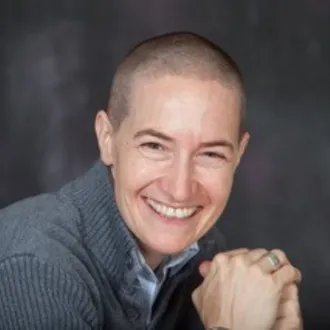All About Massage Therapy and How it Fits Into Palliative Care

Picture it: a 48-bed ICU in a corner suite. The patient asked for some water before we began his massage, but there wasn't any in his room. I asked at the nurse’s station. The nurse asked, “For which patient?” When I told her, she led me to the open door of the patient’s room, closed it, and showed me the “NPO” sign. The sign was hidden from my view, but I wouldn’t have known what it meant even if I had seen it. NPO was not a term I knew.
Thankfully, this happened on my very first shift as a hospital-based massage therapist. Twenty years later, I have thoughtful, engaged mentorship from nurses, doctors, social workers, and respiratory therapists to thank for a fulfilling and collaborative career as a uniquely valuable and much safer partner in care.
Massage therapists, like any other clinician, need mentorship and the specialized knowledge that comes from that relationship.
Massage therapists, like any other clinician, need mentorship and the specialized knowledge that comes from that relationship. Massage therapy education prepares generalists who can do excellent work with healthy populations, but there is no clear path (via a fellowship) for massage therapists who want to work in the setting of serious illness. This doesn’t mean that massage therapists don’t belong. It means that welcoming a massage therapist onto your team requires some active engagement if palliative care clinicians, the massage therapist, and the patients they touch are to realize the true benefits of the discipline of massage therapy.
I want to invite you to consider that while skilled hands are important, massage therapists can be so much more than hands. Let's dive in.
The Benefits of Massage Therapy in Serious Illness
Clinicians who have worked with massage therapists have told us (Healwell, my organization) that the potential benefits of a massage therapist go far beyond simple Likert scale measures of pain and anxiety. Patients report improved coping, peace, and hopefulness. In fact, in semi-structured interviews Healwell conducted with 20 LVAD and oncology nurses on units with palliative-trained therapists, the nurses reported that when massage therapists care for their patients, their own moral distress lessens. And many shared that after working with a massage therapist, patients are more willing to participate in other therapies and procedures (see quote below). (This paper is in progress and will be shared once published.)
“I would go into the room with the patient after the massage, and the patient was just so much more relaxed and willing to participate and engage with things that they might not necessarily have wanted to do, like getting a new IV put in, or having to go down for an MRI or a CAT scan.”
Massage therapists are generally wary of intimate, interpersonal exchanges with clients and patients. When communication is addressed in foundational massage therapy training it is typically based on somewhat rigid expectations of what is “okay” to talk about and what is “out of bounds.” As a result, many massage therapists are wary of and unprepared to navigate intimate, interpersonal exchanges with clients and patients. Luckily, with guidance from chaplaincy, social work, and other interdisciplinary team members, I have seen massage therapists learn to stay within their scope while connecting powerfully with patients and families.
When a massage therapist is empowered to bring the general skills of palliative communication and presence to their visits, patients and families share things they may not have shared with other team members.
When a massage therapist is empowered to bring the general skills of palliative communication and presence to their visits, patients and families share things they may not have shared with other team members. Massage therapists are not psychotherapists, but if they are well-mentored in working with people with serious illness, they will know how to listen and receive a patient’s experience in a way that leaves them feeling seen and heard. Mentorship will also allow the massage therapist to understand the importance of the shared information and how to use it to support team-based care
How to Integrate a Massage Therapist onto Your Team
A massage therapist can make an incredible contribution to your team and the care it provides. If you don’t already have one on your palliative care team, here’s what I suggest doing to get started:
1. Make the case to leadership
You’ll need to make the case for a massage therapist to join your team. Research is limited in this area. Much of the evidence is anecdotal or limited to the improvement of pain and anxiety. As such, you may want to consider pitching a 6-month or 12-month pilot to collect data and rich testimonials about the massage therapist’s work to ensure continued investment. For instance, how does the presence of this massage therapist impact not only patients but families and other providers?
2. Secure funding for a massage therapist to join your team
Massage therapy is not yet uniformly covered by insurance, so you may need to secure funding through philanthropic avenues, health care innovation funds, or other creative means. Fee-for-service is another option, but it can be harder to staff because the therapist would need to be on call or paid to be on-site to be available when patients want to schedule appointments.
3. Plan to have the massage therapist on site regularly
Think about the impact you want this provider to have on your patients, families, and team. Patients will benefit most when they know the massage therapist is an integrated, predictable aspect of their care. Something like eight hours per week can be a useful starting place if funding is a challenge.
4. Recruit a massage therapist
Ask your colleagues if they know of a massage therapist looking for work or create a job listing. There’s a provider directory on the Society of Oncology Massage’s website, which would also be a great place to look! If you work for a hospital, health system, or cancer center, there may be a team of massage therapists you can reach out to. Tap into your resources.
Most massage therapists are trained to work with healthy populations, and their experience mirrors that. That’s okay and to be expected! Just like other disciplines joining a palliative care team without palliative care certification (like APRNs from surgery, for instance), they will learn to safely care for these patients and their specific needs with your help. There’s also the opportunity to send them to palliative training, which I will detail later. And, of course, remember that the skills they may lack are usually not related to the hands-on components of their work. CAPC’s clinical training courses can also give them baseline knowledge for working with this population.
5. Integrate the massage therapist into your team
Invite and include them in interdisciplinary rounds and team meetings. They will need read/write access to the EMR/EHR, and you would do well to expect them to attend the same competency and clinical update meetings required of other patient-care providers.
The same goes for training. In addition to CAPC's clinical training courses, multiple organizations offer palliative training for massage therapists, which you can offer as a professional development opportunity. (See the "Resources" section below.)
Final Words
If you already have a massage therapist working with you, I invite you to consider increasing the mentorship and collaborative opportunities you provide for them. If you don’t yet have a massage therapist supporting your patients and families, I hope you will consider the steps I’ve shared above as a starting place to bring this valuable provider onto your team.
Massage therapists have the potential to bring a ton of unique value to your team and your patients.
Massage therapists have the potential to bring a ton of unique value to your team and your patients. I look forward to hearing about your challenges and your successes as you integrate these passionate providers.
Resources
To learn more about massage therapy in health care, these resources will help:
- The Society for Oncology Massage is an organization that works to ensure the safe and effective integration of massage therapy and esthetics as a standard of care for people living with cancer
- The Association for Massage Therapists in Healthcare supports healthcare-based massage therapists in their work through education, networking, compassion, and collaborative outreach to the greater health care field
If you are a massage therapist seeking professional development in the care of people living with serious illness, start here:
- CAPC offers online clinical training courses that help clinicians from all specialties and disciplines integrate palliative care skills—communication, pain and symptom management, caregiver support, and more—into patient care
- Healwell is an organization that provides comprehensive educational and training opportunities for massage therapists and allied health professionals. It offers hospital-based and oncology massage training
- UCSF offers massage therapists a year-long opportunity for hospital-based education and clinical experience with its UCSF Osher Center Advanced Training in Hospital-Based Massage Therapy Program
- Beaumont Royal Oak Hospital offers its Introduction to Oncology Massage course, which includes an optional 3-day hospital-based massage therapy clinical rotation

Be the first to read articles from the field (and beyond), access new resources, and register for upcoming events.
SubscribeEdited by Melissa Baron. Clinical review by Andrew Esch, MD, MBA.
